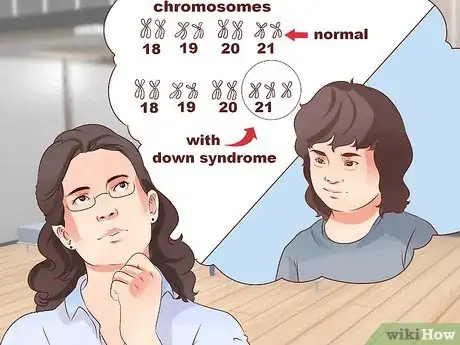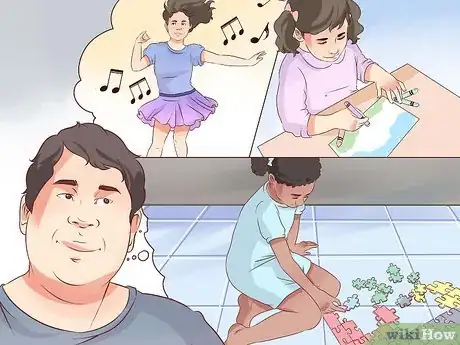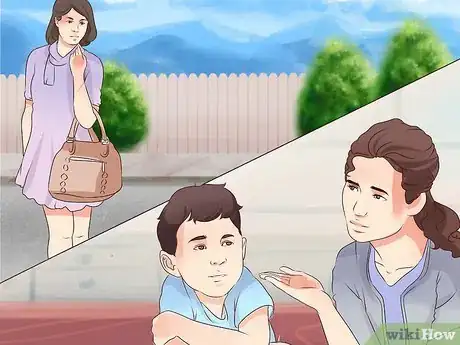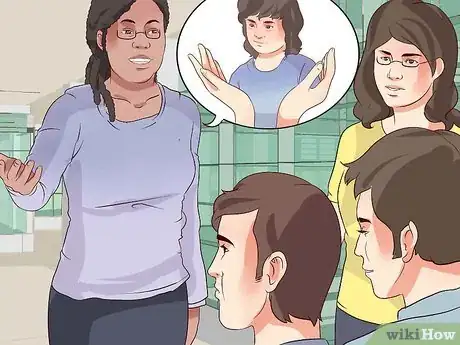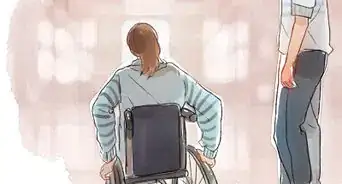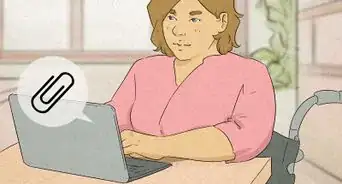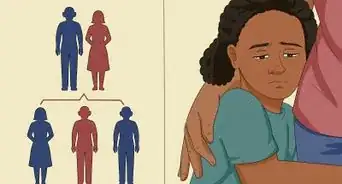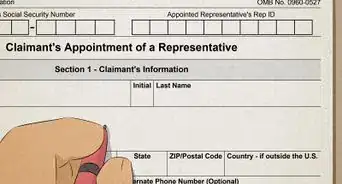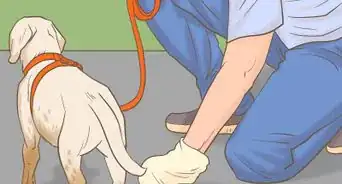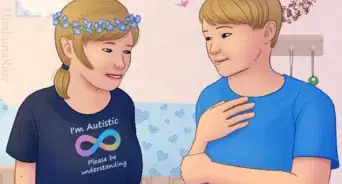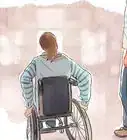This article was co-authored by Trudi Griffin, LPC, MS. Trudi Griffin is a Licensed Professional Counselor in Wisconsin specializing in Addictions and Mental Health. She provides therapy to people who struggle with addictions, mental health, and trauma in community health settings and private practice. She received her MS in Clinical Mental Health Counseling from Marquette University in 2011.
There are 15 references cited in this article, which can be found at the bottom of the page.
This article has been viewed 40,324 times.
With a network of loved ones, friends, educators, and medical professionals, children with Down syndrome can thrive and lead full lives. Society has come a long way in how children with this condition are treated, though misconceptions still exist. Learn what steps you can take to help a child with Down syndrome.
Steps
Understanding Down Syndrome
-
1Learn what Down syndrome is. Down syndrome is a genetic disorder. It happens when someone is born with an extra copy of chromosome 21. This extra genetic material affects a person’s development.[1]
- Down syndrome causes changes in physical development. People with Down syndrome may be more prone to medical conditions like heart or respiratory issues. Lower muscle tone, smaller stature, and flat facial features also affect some people with Down syndrome.[2]
- People with Down syndrome typically have some sort of intellectual disability. This means they develop at a slower pace or take longer to learn new information. For example, a child with Down syndrome may learn to walk later than most children. An adult with Down syndrome may need extra help learning a new task.
- Every person with Down syndrome is an individual. Physical and intellectual development varies greatly from person-to-person. Most issues affecting development are mild to moderate. With modern medical care, people with Down syndrome have an average life expectancy of 60 years.[3]
-
2Recognize the abilities and talents of children with Down syndrome. Children with Down syndrome lead rich and fulfilling lives. Their personalities and talents are just as varied as any other child’s. They have a full range of emotions, from pride and happiness to fear and disappointment.[4]
- Many children with Down syndrome are in regular education classrooms. They may get extra support for certain subjects like reading or math. With the right support, most children learn to read and write. Eventually they can get vocational training, hold jobs, and some even go to college.
- Just like other children, children with Down syndrome have different talents and strengths. Some love music and art while others like to play sports. Some are shy and timid while others are outgoing and bold.
Advertisement -
3Be aware of misconceptions about Down Syndrome. In the not too distant past, children with Down syndrome were treated poorly by society. They were sent away to institutions and denied appropriate medical care and learning support. Unfortunately, negative perceptions still exist. Society is not always accepting of people with Down syndrome. [5]
- Adults and children may tease, taunt, and avoid children with Down syndrome. Those with Down syndrome experience pain and hurt just like any other person. Social rejection damages their self-esteem.
- As they get older, they may be passed over for a job because of their condition. It’s a misconception that people with Down syndrome can’t work or take care of themselves. Most people with this condition grow into productive adults who can contribute to society.[6]
- Children with Down syndrome face hurdles like discrimination and lack of acceptance. They need extra support from their loved ones and caregivers so they can overcome these obstacles.
Supporting a Child with Down Syndrome
-
1Get medical support for your child. Make sure your loved one has all the support they need to succeed at home and at school. Since every child with Down syndrome is unique, they each need a personalized plan to help them reach their full potential.
- Find a pediatrician or primary care provider that you trust. The pediatrician should have strong communication skills and experience with Down syndrome, or be willing to learn about the condition. A pediatrician helps you coordinate your child’s medical care.[7] [8]
- Connect with your local early intervention services. They can help babies and toddlers with developmental delays and learning disabilities. Services like occupational, physical and speech therapy are often low cost or free. Contact the Early Childhood Technical Assistance Center in your state: http://ectacenter.org/contact/ptccoord.asp. Tell them you want early intervention services and need to schedule an evaluation.[9]
-
2Get educational support for your child. Partner with your child’s school. You need to work as a team with teachers and school counselors to make sure your child is getting all the academic and social support they need.[10]
- Many children benefit from inclusion, which is attending regular education classes, with extra support. Others benefit from attending special education classes, or a combination of regular and special education.[11] [12]
- By law, children with Down syndrome who attend public school are entitled to an Individualized Education Plan or IEP. This is a plan you create with the school that addresses your child’s specific learning needs. It is reviewed each year.[13]
- Contact the school counselor and say you want to set up an IEP. The school will schedule an evaluation and then you’ll attend meetings to create and approve the IEP.[14]
-
3Teach your child how to make friends. Children with Down syndrome benefit from practicing social skills. Making friends can be a challenge for any child. Children with this condition sometimes have a harder time dealing with peers.[15]
- Talk about friendly and unfriendly actions and who makes a good friend. Kids who are smiling and use kind words are good new friends. Kids who ignore you, walk away, or say mean things are people to avoid.
- Practice how to start a conversation. Once your child learns about who to approach and who to stay away from, practice what to say to a new friend. Work on how to introduce yourself. For example, “Hi! My name is Anna. What’s your name? What’s your favorite game to play?” Take turns rehearsing different conversation starters with your child.
- Teach your child how to deal with mean or hurtful behavior. Talk to your child about what they can do if someone is unkind or mean. For example, tell the person to stop, get help from a teacher, or walk away.
- Schedule play dates. Get to know other parents and help your child interact with their new friends.
-
4Take a break. You may be a parent, sibling, grandparent or a caregiver of a child with Down syndrome. Helping a child with special needs can be hard at times. When you feel like you're burnt out or your patience is running low, get help. Take a break and share responsibilities with others. You have to take care of yourself first before you can take care of someone else.[16]
- Make time for yourself. Even if you only have five minutes, spend it doing something relaxing. Take a walk, read, or stretch. Brief breaks can help you recharge.
- Create a caregiver or helper schedule. For example, an older sibling helps with homework, a friend practices baseball, and you help with bedtime.
- Consider respite services. Each state has respite services for caregivers of children with special needs. Respite care gives you a break while a professional care provider watches your child. The ARCH National Respite Network has a state-by-state locator tool: http://archrespite.org/us-map.
Becoming an Advocate for People with Down Syndrome
-
1Model accepting and kind behavior. As a friend or loved one of a child with Down syndrome, you can show others that having Down syndrome doesn’t get in the way of living a full life. By having fun, playing, and hanging out with a child with Down syndrome, you’re showing the world how they should treat children with special needs — with caring, kindness, and respect, like any other child.
- Talk to your child’s school about how they promote acceptance. Ask what they do to educate children about diversity and accepting differences. How do they promote and model respect? If your school doesn’t have diversity and acceptance programs, recommend they create some.
-
2Create a support network. Connect with people in the Down syndrome community to help yourself, your child, and other families. There are online and in-person groups for parents and caregivers, siblings, and people with Down syndrome.[17]
- Many local groups have community outreach activities to raise awareness and funding for Down syndrome. Contact the National Down Syndrome Society Helpline to find groups and resources in your area.
-
3Get involved. Join local organizations that advocate for children with Down syndrome. By becoming a member, donor, or volunteer, you are taking steps to educate the public about this condition. Education dispels myths about Down syndrome and helps build a more accepting society.
- The Special Olympics helps people with intellectual disabilities build their confidence and abilities through sports.
- The Government Affairs Committee works to improve public policy and laws for those with Down syndrome and intellectual special needs. Join or start a National Down Syndrome Society Government Affairs Committee.
References
- ↑ http://www.ndss.org/Down-Syndrome/Down-Syndrome-Facts/
- ↑ http://www.webmd.com/children/understanding-down-syndrome-symptoms
- ↑ http://www.ndss.org/Down-Syndrome/Myths-Truths/
- ↑ http://www.dseinternational.org/en-us/about-down-syndrome/development/
- ↑ http://www.globaldownsyndrome.org/about-down-syndrome/the-story-of-two-syndromes/
- ↑ http://www.globaldownsyndrome.org/about-down-syndrome/misconceptions-vs-reality/
- ↑ http://www.globaldownsyndrome.org/about-down-syndrome/facts-about-down-syndrome/#medical
- ↑ http://pediatrics.aappublications.org/content/pediatrics/128/2/393.full.pdf
- ↑ http://www.parentcenterhub.org/repository/ei-overview/
- ↑ http://www.ndss.org/Resources/Wellness/Recreation-Friendship/
- ↑ http://mn.gov/mnddc//parallels2/pdf/00s/00/00-IIS-INS.pdf
- ↑ http://www.ndss.org/Resources/Wellness/Recreation-Friendship/
- ↑ http://www2.ed.gov/parents/needs/speced/iepguide/index.html
- ↑ http://www2.ed.gov/parents/needs/speced/iepguide/index.html
- ↑ http://www.greatschools.org/gk/articles/understanding-the-language-of-friendship/
- ↑ http://www.cdc.gov/family/specialneeds/
- ↑ http://www.ndss.org/Resources/New-Expectant-Parents/Finding-Support/
